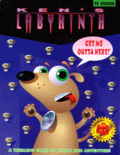
































Ken’s Labyrinth

Ken's Labyrinth is a first-person shooter DOS game, released in 1993 by Ken Silverman through his Advanced Systems and later by Epic MegaGames. It was fully coded by Ken Silverman, who later went on to design the Build engine that was used for rendering a first-person viewpoint in 3D Realms's Duke Nukem 3D (1996) and most recently in Ion Fury (2019). It consists of three episodes, the first of which was released as shareware.
Ken's Labyrinth is graphically similar to id Software's Wolfenstein 3D in that the levels were designed using a grid-based plane, resulting in perpendicular walls and textureless floors and ceilings. Arguably its most astounding feature was the existence of interactive sprites and textures, like slot machines. This move towards engines allowing greater interactivity was later elaborated upon by Silverman's Build engine.
Ken's Labyrinth was released as freeware on November 16, 1999. Several different versions were released and are available for download from the official website. The source code followed on July 1, 2001.
The first version is known as Walken, the version which Ken Silverman sent to companies for evaluation. This was the first version created, and therefore it had very few features. There was almost no interactivity, and the code was mostly a test.
The first version to be released was a modified version of Walken called Ken's Labyrinth. Many changes were made, including interactivity, an early money system and music. It was sold by Ken directly, using the Advanced Systems company name, a company that Ken's older brother Alan Silverman was involved with.
Following that was version 1.1, which featured 27 levels and an alternate final boss. New enemies, textures and music were added, as well as a money system with which the player could locate money and use it to purchase a random item from a vending machine. Slot machines were also implemented.
Released in March 1993 by Epic MegaGames, the final version (2.01) featured 30 levels, and many new features that older versions of the game lacked, such as the ability to choose the item purchased from the vending machines, a difficulty option (on 'easy' mode, or 'Don't hurt me,' enemies do not use melee attacks, while on 'hard' mode, or 'Ouch!' they do), an episode select, and also new enemies, textures and music.
A Ken's Labyrinth port to modern operating systems such as Windows and Linux using Simple DirectMedia Layer called LAB3D/SDL was created by Jan Lönnberg and released in 2002. A version of the port which includes new higher resolution textures was also created by Katie Stafford.
How to play:
Click on the joystick icon in the Ken’s Labyrinth online emulator to see how to control the Ken’s Labyrinth game









































Comments